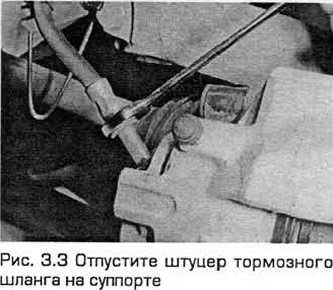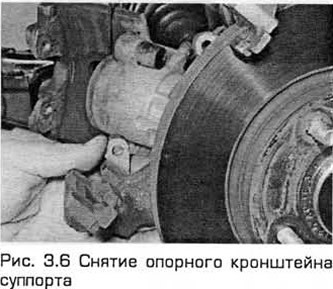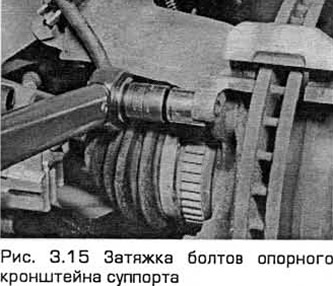Note: See Warning paragraph 2.
Withdrawal
1. Apply the parking brake. Loosen the front wheel nuts, raise the front end and place it on stands. Remove the corresponding front wheel.
2. Install the clamp on the brake hose going to the front brake caliper. This is necessary to reduce fluid leakage during subsequent operations (see fig. 3.2).

3. Let go (without turning completely) brake hose fitting located on the caliper (see fig. 3.3).

4. Remove the front brake pads (paragraph 2).
5. While holding the caliper with your hand, hold the hose with your other hand so that it does not turn. Turning the caliper relative to the hose, unscrew it from the fitting, being careful not to twist or pull the hose. Immediately after disconnecting the caliper, plug the holes in the caliper and hose so that dust or dirt does not get into them.
6. If necessary, the caliper support bracket can be removed by unscrewing its bolts from the steering knuckle (see fig. 3.6).

Repair
7. Install the caliper on the workbench. Remove all dirt and dust from it with a brush. Do not breathe the dust, it can be dangerous.
8. Remove the rubber dust seal from the piston end.
9. With compressed air (under low pressure, e.g. from a foot-operated tire inflation pump) press the piston out of the hole by connecting an air hose to the pressure line fitting.
Caution: The piston may jump out of the bore abruptly. Insert a thin wooden spacer between the piston and the caliper body so that if the piston suddenly comes out, its end is not damaged.
10. Pull the piston collar out of the cylinder groove. To do this, use a tool with a hook-shaped end. Be careful not to scratch the surface of the cylinder.
11. Wash the piston and caliper body with methanol and dry them. Inspect piston and cylinder surfaces for wear, damage, and corrosion. If the piston is defective, purchase a new one along with the seal. If the cylinder has defects, then the entire caliper must be replaced. Seals must be replaced regardless of the condition of other components.
12. Lubricate the piston and seal with clean brake fluid. Insert the piston seal into the cylinder groove.
13. Press the piston into the cylinder without distortion.
14. Install a dustproof rubber seal on the piston and caliper, and then completely press the piston into the cylinder.
Installation
15. Install the caliper and support bracket (where needed) in reverse order of removal. Make sure the brake hose is not twisted. Tighten the mounting bolts and wheel nuts to the required torque (see fig. 3.15).

16. Eliminate air from the brake system (paragraph 15). Do not forget to remove the clamp from the hose. Make sure there are no leaks at the hose connection. Check your brakes carefully before you start driving.
Visitor comments